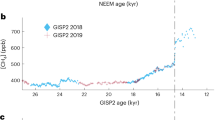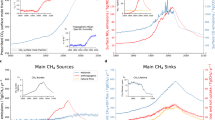Abstract
Atmospheric methane is an important greenhouse gas and a sensitive indicator of climate change and millennial-scale temperature variability1. Its concentrations over the past 650,000 years have varied between ∼350 and ∼800 parts per 109 by volume (p.p.b.v.) during glacial and interglacial periods, respectively2. In comparison, present-day methane levels of ∼1,770 p.p.b.v. have been reported3. Insights into the external forcing factors and internal feedbacks controlling atmospheric methane are essential for predicting the methane budget in a warmer world3. Here we present a detailed atmospheric methane record from the EPICA Dome C ice core that extends the history of this greenhouse gas to 800,000 yr before present. The average time resolution of the new data is ∼380 yr and permits the identification of orbital and millennial-scale features. Spectral analyses indicate that the long-term variability in atmospheric methane levels is dominated by ∼100,000 yr glacial–interglacial cycles up to ∼400,000 yr ago with an increasing contribution of the precessional component during the four more recent climatic cycles. We suggest that changes in the strength of tropical methane sources and sinks (wetlands, atmospheric oxidation), possibly influenced by changes in monsoon systems and the position of the intertropical convergence zone, controlled the atmospheric methane budget, with an additional source input during major terminations as the retreat of the northern ice sheet allowed higher methane emissions from extending periglacial wetlands. Millennial-scale changes in methane levels identified in our record as being associated with Antarctic isotope maxima events1,4 are indicative of ubiquitous millennial-scale temperature variability during the past eight glacial cycles.
This is a preview of subscription content, access via your institution
Access options
Subscribe to this journal
Receive 51 print issues and online access
$199.00 per year
only $3.90 per issue
Buy this article
- Purchase on SpringerLink
- Instant access to full article PDF
Prices may be subject to local taxes which are calculated during checkout



Similar content being viewed by others
References
Delmotte, M. et al. Atmospheric methane during the last four glacial–interglacial cycles: Rapid changes and their link with Antarctic temperature. J. Geophys. Res. 109, 12104 (2004)
Spahni, R. et al. Atmospheric methane and nitrous oxide of the Late Pleistocene from Antarctic ice cores. Science 310, 1317–1321 (2005)
Denman, K. L. et al. in Climate Change 2007: The Physical Science Basis. Contribution of Working Group I to the Fourth Assessment Report of the Intergovernmental Panel on Climate Change (eds Solomon, S. et al.) 499–587 (Cambridge Univ. Press, 2007)
Blunier, T. & Brook, E. J. Timing of millennial-scale climate change in Antarctica and Greenland during the last glacial period. Science 291, 109–111 (2001)
Parrenin, F. et al. The EDC3 chronology for the EPICA Dome C ice core. Clim. Past 3, 485–497 (2007)
Loulergue, L. et al. New constraints on the gas age–ice age difference along the EPICA ice cores, 0–50 kyr. Clim. Past 3, 527–540 (2007)
Blunier, T. et al. Synchronization of ice core records via atmospheric gases. Clim. Past 3, 325–330 (2007)
EPICA Community Members. One-to-one coupling of glacial climate variability in Greenland and Antarctica. Nature 444, 195–198 (2006)
Jouzel, J. et al. Orbital and millennial Antarctic climate variability over the past 800000 years. Science 317, 793–796 (2007)
Lüthi, D. et al. High-resolution carbon dioxide concentration record 650,000–800,000 years before present. Nature 10.1038/nature06949 (this issue)
Chappellaz, J. et al. Synchronous changes in atmospheric CH4 and Greenland climate between 40 and 8 kyr bp. Nature 366, 443–445 (1993)
Prigent, C., Matthews, E., Aires, F. & Rossow, W. B. Remote sensing of global wetland dynamics with multiple satellite data sets. Geophys. Res. Lett. 28, 4631–4634 (2001)
Keppler, F., Hamilton, J. T. G., Brass, M. & Röckmann, T. Methane emissions from terrestrial plants under aerobic conditions. Nature 439, 187–191 (2006)
Dueck, T. A. et al. No evidence for substantial aerobic methane emission by terrestrial plants; a 13C-labelling approach. New Phytol. 175, 29–35 (2007)
Walter, B. P. & Heimann, M. A process-based, climate-sensitive model to derive methane emissions from natural wetlands: Application to five wetland sites, sensitivity to model parameters, and climate. Glob. Biogeochem. Cycles 14, 745–766 (2000)
Kaplan, J. O., Folberth, G. & Hauglustaine, D. A. Role of methane and biogenic volatile organic compound sources in late glacial and Holocene fluctuations of atmospheric methane concentrations. Glob. Biogeochem. Cycles 20, GB2016 (2006)
Thonicke, K., Prentice, C. I. & Hewitt, C. D. Modelling glacial–interglacial changes in global fire regimes and trace gas emissions. Glob. Biogeochem. Cycles 19, GB3008 (2005)
Kennett, J. P., Cannariato, K. G., Hendy, I. L. & Behl, R. J. Carbon isotopic evidence for methane hydrate instability during quaternary interstadials. Science 288, 128–133 (2000)
Lisiecki, L. E. & Raymo, M. E. A Pliocene-Pleistocene stack of 57 globally distributed benthic δ18O records. Paleoceanography 20, PA2007 (2005)
Schmidt, G. A., Shindell, D. T. & Harder, S. A note on the relationship between ice core methane concentrations and insolation. Geophys. Res. Lett. 31, L23206 (2004)
Liu, Z., Otto-Bliesner, B., Kutzbach, J., Li, L. & Shields, C. Coupled climate simulation of the evolution of global monsoons in the Holocene. J. Clim. 16, 2472–2490 (2003)
Chiang, J. C. H., Biasutti, M. & Battisti, D. S. Sensitivity of the Atlantic Intertropical Convergence Zone to Last Glacial Maximum boundary conditions. Paleoceanography 18, 1094 (2003)
Clement, A. C., Hall, A. & Broccoli, A. J. The importance of precessional signals in the tropical climate. Clim. Dyn. 22, 327–341 (2004)
Sun, Y. et al. East Asian monsoon variability over the last seven glacial cycles recorded by a loess sequence from the northwestern Chinese Loess Plateau. Geochem. Geophys. Geosyst. 7, Q12Q02 (2006)
Fischer, H. et al. Changing boreal methane sources and constant biomass burning during the last termination. Nature 452, 864–867 (2008)
Spahni, R. et al. The attenuation of fast atmospheric CH4 variations recorded in polar ice cores. Geophys. Res. Lett. 30, 1571 (2003)
McManus, J. F. A 0.5-million year record of millennial scale climate variability in the North Atlantic. Science 283, 971–975 (1999)
Paillard, D., Labeyrie, L. & Yiou, P. Macintosh program performs time-series analysis. EOS Trans. Am. Geophys. Un. 77, 379 (1996)
Acknowledgements
This work is a contribution to the European Project for Ice Coring in Antarctica (EPICA), a joint ESF (European Science Foundation)/EC scientific program, funded by the European Commission and by national contributions from Belgium, Denmark, France, Germany, Italy, the Netherlands, Norway, Sweden, Switzerland and the United Kingdom. The main logistic support was provided by IPEV and PNRA (at Dome C). Additional funding support of this work was provided by the European FP6 STREP “EPICA-MIS”, by the French ANR PICC (ANR-05-BLAN-0312-01) and by CNRS/INSU programs. We thank the technical team on the field and all those who helped with the methane measurements at Grenoble (B. Bellier, L. Isabello, E. Estrangin, L. Chan-Tung) and at Bern (G. Hausammann). We also thank P. Yiou and P. Naveau for their spectral analysis courses at LSCE, and H. Fischer and G. Dreyfus for their comments. This is EPICA publication no. 195.
Author information
Authors and Affiliations
Corresponding author
Supplementary information
Supplementary information
This file provides details on the methane measurements with the offset corrections between the two laboratories (LGGE, Bern) and between Vostok and EDC measured in Grenoble. A note on the time resolution of the CH4 measurements (Figure S2), on the correlation between CH4 and EDC temperature warmth maxima (Figure S3) and on the details of the spectral analyses are added. It includes also supplementary figures S1 (CH4 comparison between Greenland and EDC ice cores), and S4 (phase wheels showing the phase relationship between insolation, CH4 and other proxies). (PDF 405 kb)
The file contains Supplementary Table.
This file provides the CH4 data of the last 800,000 years from the EPICA Dome C ice core. The CH4 concentrations are listed against depth and the corresponding EDC3_gas_a age. (XLS 270 kb)
Rights and permissions
About this article
Cite this article
Loulergue, L., Schilt, A., Spahni, R. et al. Orbital and millennial-scale features of atmospheric CH4 over the past 800,000 years. Nature 453, 383–386 (2008). https://doi.org/10.1038/nature06950
Received:
Accepted:
Issue date:
DOI: https://doi.org/10.1038/nature06950
This article is cited by
-
Dansgaard-Oeschger cycles of the penultimate and last glacial period recorded in stalagmites from Türkiye
Nature Communications (2024)
-
Early warning signals of the termination of the African Humid Period(s)
Nature Communications (2024)
-
Seasonal temperatures in West Antarctica during the Holocene
Nature (2023)
-
Dichotomy between freshwater and heat flux effects on oceanic conveyor belt stability and global climate
Communications Earth & Environment (2023)
-
The PaleoJump database for abrupt transitions in past climates
Scientific Reports (2023)



